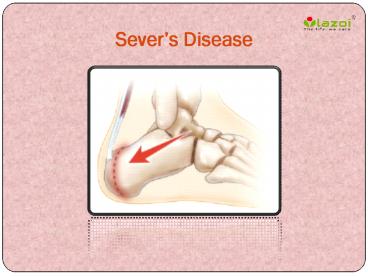Pes Cavus: Causes, Symptoms, Daignosis, Prevention and Treatment (1) - PowerPoint PPT Presentation
Title:
Pes Cavus: Causes, Symptoms, Daignosis, Prevention and Treatment (1)
Description:
Sever’s Disease is known to be the most common form of heel pain that is experienced by children and adolescents. – PowerPoint PPT presentation
Number of Views:89
Title: Pes Cavus: Causes, Symptoms, Daignosis, Prevention and Treatment (1)
1
Severs Disease
2
Severs Disease
- Severs disease is known to be the most common
form of heel pain that is experienced by children
and adolescents. As the bones grow in the leg and
foot, an extra tension is put on the tendons and
ligaments which can further cause trauma to the
growth plate in the heel bone.Generally,
Severs Disease affects children aged between
10-12 years and is most common in males.
3
How is Severs disease diagnosed?
- There are a number of techniques that a
podiatrist can do to diagnose Severs disease. To
begin with, a baseline assessment of the legs and
feet should be conducted to identify any
abnormalities such as tight muscle groups or flat
feet.This baseline assessment should also
include an inspection of the patient walking.
Identifying any underlying problems or
abnormalities is important so that the correct
treatment can be used.A footwear assessment is
another important factor when diagnosing Severs
disease unsupportive, or worn out shoes may be
further contributing to the symptoms.
4
Will Severs disease resolve?
- Severs disease is classified as a self-limiting
condition which means that with time the
condition will generally go away on its own.
Return to normal activity is usually possible
after approximately two to three months however
this does vary.Treatments such as those
mentioned above should not only reduce the
healing time but improve the quality of life of
the child by reducing pain levels and increasing
functionality.Recurrence of Severs disease is
rare however long term management strategies such
as orthotics may be necessary in patients with
certain foot types to prevent the development of
other pathologies later in life.
5
What are the signs symptoms of Severs Disease?
- Pain when squeezing the heel bone
- Pain is worse when standing or wearing closed
shoes - Tight calf muscles
- Tenderness along the Achilles tendon
- Decreased movement at the ankle joint
- Symptoms often worsen at the beginning of a
sports season - Symptoms worsen during a growth spurt
- Heel pain during physical activity
6
How is Severs disease managed?
- Rest from activities that increase the pain
- Ice should be applied for 20 minutes every hour
to assist in decreasing the pain and swelling - Anti-inflammatory medications and topical creams
are also useful in reducing the swelling and pain
in the short term - Strapping tape can be used to improve the
alignment of the foot and ankle - A heel raise placed in the childs shoes can be
useful in reducing symptoms - Stretching exercises of the calf muscles are
almost always essential - Good, supportive footwear should be worn
especially when playing sport - Orthotics may be necessary for patients with
underlying problems such as flat feet
7
CONNECT WITH US
- Logon to
- www.lazoi.com
- Like us on Facebook
- https//www.facebook.com/LazoiTheLife
- Follow us on Twitter
- https//www.twitter.com/lazoithelife
- Follow us on Pinterest
- https//www.in.pinterest.com/lazoithelife































